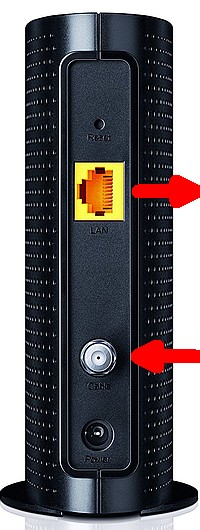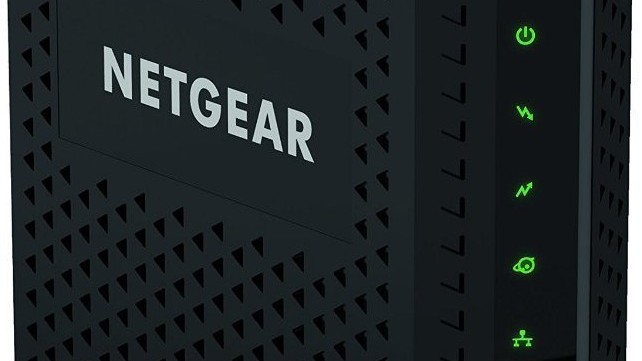A modem is the device that connects to your ISP (Internet Service Provider). That's all it does. The input to a modem is a wire from your ISP. The output is a single Ethernet port. If you connect via cable, the wire from your ISP is coaxial. If you connect with DSL, the wire is a phone wire. If you connect optically, the wire from your ISP is an optical cable. If you use a satellite to connect to your ISP, there is no wire.
Modems do not do Wi-Fi or VOIP telephone service. Depending on your ISP, you may have a modem as a standalone device, or, the functionality of a modem can be combined with that of a router into a single device called a "gateway" (or sometimes a "modem router"). See also, my introduction to routers. Too often, the term "modem" is used to refer to a gateway device.
Modems are computers and thus need a minute or so after being powered on before they are fully functional. And, like all computers, the software they run sometimes needs to be updated. With cable modems, in the US, only the ISP can update the software (called firmware) in the modem. For any given cable modem, an ISP may or may not keep the firmware current. Netgear has a report card on this: What is the latest firmware version of my NETGEAR cable modem or modem router? that shows a drastic difference between ISPs. Netgear has continually updated this page for years. When I checked on April 22, 2024, the last update was two days earlier. I first ran across this Netgear page in 2021, if not earlier.

You can easily tell if a device is a modem by looking at it, both the back and the front.
This is an image of the back panel of a TP-Link TC-7610 cable modem. The coaxial cable jack is input, Ethernet is output. The circular connector at the bottom is for electricity. A router or gateway would have more than one Ethernet jack. A gateway might also have telephone jacks.

This is an image of the front of a Netgear CM600 cable modem. It has indicator lights for power, downstream status, upstream status, Internet connection and Ethernet connection. There is nothing about Wi-Fi and nothing about telephone line(s).
One nice thing about Netgear modems is that they use green to indicate a good status. Even without any understanding of what each light refers to, simply seeing that all the lights are green, shows that everything is working correctly. This is not true of all brands. Arris, for example, uses white and blue lights and they refer to the white ones as green in their documentation. Also, the lights on a Netgear modem are not too bright. I have lived with an Arris modem and I had to put tape over one of the lights because it was way too bright.
Cable Haunt Modem Flaw
In January 2020 we learned of a flaw in modems that use a chipset from Broadcom. The flaw is called CableHaunt and, in the US, it is likely that very few modems will ever be fixed. My summary is on the Bugs page. It is very unlikely that either your ISP or the modem vendor will every say anything about this.
To know if your modem is vulnerable, you first need to do a port scan of it from the LAN side. If there are any open ports, other than the one used for its web interface, then it may be vulnerable. Try to connect to the port with a web browser and see what's there. If its a spectrum analyzer, you need to block access to the modem from the LAN side with your router.
Other Known Modem Flaws
You probably should avoid buying the Arris SB6190 and the Netgear CM700 modems due to problems with the Intel Puma 6 chipset. See these articles:
- Intel's buggy Puma 6 chipset earns Arris a gigabit-modem lawsuit by Shaun Nichols of The Register April 11, 2017
- FYI: You can blow Intel-powered broadband modems off the 'net with a 'trivial' packet stream by Shaun Nichols of The Register April 27, 2017. A modem using Intel's Puma 6 chipset can be overloaded and virtually knocked offline by a small amount of incoming data. There is no mitigation, but it does require a constant attack. When the attack stops, things return to normal. The bug has to do with exhausting an internal lookup table. Known vulnerable devices are the Arris SB6190 and the Netgear CM700. The Puma 6 chipset is also used in some ISP-branded cable modems, including some Xfinity boxes supplied by Comcast in the US and the latest Virgin Media hubs in the UK such as the Super Hub 3. Earlier articles mentioned a possible modem firmware update. However, even if a fix is issued you are at the mercy of your ISP to install it.
- Netgear confirms: Intel's wobbly Puma 6 in fast broadband modems is super-easy to choke out by Shaun Nichols of The Register May 1, 2017. The hardware is prone to degraded performance when sent a stream of small, or zero-sized, TCP or UDP packets spread over multiple ports. Every incoming packet is recorded in a look-up table by the chipset. I packets target a large range of ports at once, with 3,000 to 5,000 packets/second the look-up table can fill up and cripple performance. One engineer said it was "trivial" to overwhelm vulnerable devices. There was, at the time the article was written, no fix available.
- Security Advisory for Vulnerability on Select Cable Modems and Gateways, PSV-2017-2165 from Netgear. Last updated May 30, 2017. There is no fix available. Vulnerable devices are the C6300, CM400, CM700 and CMD31T. It seems Netear did nothing about this problem. And, they certainly lied when they said "NETGEAR is working to evaluate this vulnerability and will update this security advisory as more information becomes available." As of July 2018, there has been no update.
- Intel Pumageddon: Broadband chip bug haunts Chipzilla's past, present and future by Shaun Nichols of The Register August 9, 2017.
- Modems using the Puma 6 chipset. From DSL Reports. Branded boxes offered by Comcast and Virgin Media, as well as modems from Hitron and Compal and network gear from Cisco and Linksys, were all said to use the lag-prone Puma 6 chipset.
- Intel finally emits Puma 1Gbps modem fixes – just as new ping-of-death bug emerges by Shaun Nichols of The Register August 14, 2018
- Cable modem Puma 6 chipset test at DSL Reports. Note: only available via HTTP
There is even a website about this, badmodems.com, but I can not vouch for it. In the same vein, the ApprovedModems.org website has a List of 71 Bad Cable Modems You Should Avoid Buying (June 11, 2020).
Modem Articles
This is a miserable article: The Best Cable Modem by The WireCutter, last updated March 29, 2021. The author seems to have no experience with cable modems at all. Amateur hour. As for specifics:
- The article says nothing about technical support. Netgear, I learned the hard way, offers free tech support for a very short period of time. After that, you have to pay. This is an issue for non-techies because buying your own modem means the ISP is no longer fully responsible for making the Internet work. They can just blame the modem.
- The topic on telephone service omits an important issue. While the modems do not have telephone jacks, it is possible that they can be used anyway. An ISP may provide customers with a telephone adapter box that can be plugged into either a router via Ethernet or spliced into the coaxial cable.
- Quoting: "generally speaking, modems either work or don't." Nuf said.
- The article fails to mention that some modems can be password protected and some can not. It's a useful feature to people that care about security.
- The article says nothing about firmware updates. In the US, the ISP has the sole responsibility to update the software in the modem. Do some ISPs do a better job that others? I know my ISP is miserable at updating my modem. Many people work for the Times and the Wire Cutter. This could have been researched, but, no.
- The article says nothing about the Cable Haunt flaw. Which modems are still vulnerable? Which are not? None of our business.
- When things go wrong, looking at the modem can be invaluable. Which modems provide useful statistics? Which have an event log? Another topic not mentioned. The article does not even mention that a modem is a computer with an administrative web interface that you can review.
Talk to your modem by me February 5, 2015. Those of us with separate modems and routers are likely to focus on the router and ignore the modem. But, like a router, a broadband modem is a computer with a web based user interface. And, like any device with a web interface, the modem has an IP address. You might think that to address a modem by its IP address, you would have to connect a computer directly to the Ethernet port of the modem. In fact, I have seen instructions for a cable modem that said to do just that. But this is not always the case.
Using a router to block a modem by me February 23, 2015. A follow-up to the previous blog (above) that described how IP address 192.168.100.1 is likely to provide access to a modem, through a router. This can leave an Arris/Motorola modem vulnerable to hacking from the LAN. But, there is a defense.
The Spectrum Mystery Modem E31_2V1 at Larry Talks Tech, July 2019
Best Cable Modems 2018 by Philip Michaels of Toms Guide February 14, 2018. I disagree about the recommendation for an Arris modem, but the article is a worthwhile read. Two good charts: cost of Renting vs. Buying a modem and Modem Compatibility With ISPs. I agree that the Netgear CM600 is a good choice. Its great that the problems with the Arris Surfboard SB6190 are mentioned. Also great is the heads up about the Linksys CM3024 and the recommendation to use a separate router and modem. The article, however, fails to mention any password protection offered by the modems. Netgear offers it, Arris does not. Finally, note that the links in this article are affiliate links, that is, Toms Guide gets a cut if you buy a modem via a link in this article.
A tale of two cable modems by me October 25, 2017. After I replaced an Arris cable modem with a Netgear model, these were my thoughts comparing the two. In short, I much prefer the Netgear modem.
How to Get the Best Cable Modem: Should You Buy or Rent? PC Magazine Jan. 27, 2017. Modems are measured by the number of communication channels. A 16x4 modem has 16 downstream channels and 4 upstream. 16 channels down can support speeds up to 680Mpbs. 8 downstream channels maxes out at about 340Mbps. 4 channels up supports roughly 130Mbps. Higher end modems are 24x8. The Netgear CM700 is 32x8 and advertised as supporting 1.4 Gigabits/second downstream.